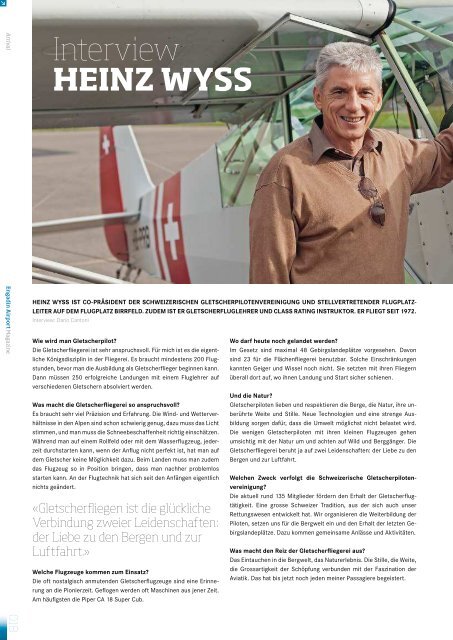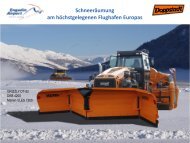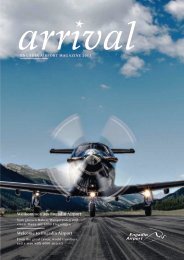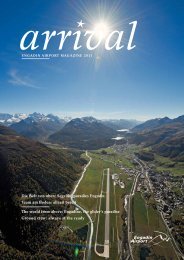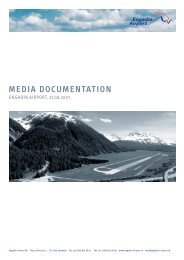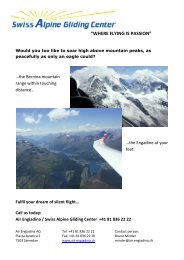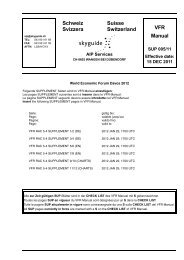Arrival Magazin 2014 - Airport Samedan
Arrival Magazin 2014 - Airport Samedan
Arrival Magazin 2014 - Airport Samedan
Sie wollen auch ein ePaper? Erhöhen Sie die Reichweite Ihrer Titel.
YUMPU macht aus Druck-PDFs automatisch weboptimierte ePaper, die Google liebt.
<strong>Arrival</strong> Engadin <strong>Airport</strong> <strong>Magazin</strong>e<br />
Interview<br />
HEINZ WYSS<br />
HEINZ WYSS IST CO-PRÄSIDENT DER SCHWEIZERISCHEN GLETSCHERPILOTENVEREINIGUNG UND STELLVERTRETENDER FLUGPLATZ-<br />
LEITER AUF DEM FLUGPLATZ BIRRFELD. ZUDEM IST ER GLETSCHERFLUGLEHRER UND CLASS RATING INSTRUKTOR. ER FLIEGT SEIT 1972.<br />
Interview: Dario Cantoni<br />
Wie wird man Gletscherpilot?<br />
Die Gletscherfliegerei ist sehr anspruchsvoll. Für mich ist es die eigentliche<br />
Königsdisziplin in der Fliegerei. Es braucht mindestens 200 Flugstunden,<br />
bevor man die Ausbildung als Gletscherflieger beginnen kann.<br />
Dann müssen 250 erfolgreiche Landungen mit einem Fluglehrer auf<br />
verschiedenen Gletschern absolviert werden.<br />
Was macht die Gletscherfliegerei so anspruchsvoll?<br />
Es braucht sehr viel Präzision und Erfahrung. Die Wind- und Wetterverhältnisse<br />
in den Alpen sind schon schwierig genug, dazu muss das Licht<br />
stimmen, und man muss die Schneebeschaffenheit richtig einschätzen.<br />
Während man auf einem Rollfeld oder mit dem Wasserflugzeug, jederzeit<br />
durchstarten kann, wenn der Anflug nicht perfekt ist, hat man auf<br />
dem Gletscher keine Möglichkeit dazu. Beim Landen muss man zudem<br />
das Flugzeug so in Position bringen, dass man nachher problemlos<br />
starten kann. An der Flugtechnik hat sich seit den Anfängen eigentlich<br />
nichts geändert.<br />
«Gletscherfliegen ist die glückliche<br />
Verbindung zweier Leidenschaften:<br />
der Liebe zu den Bergen und zur<br />
Luftfahrt.»<br />
Welche Flugzeuge kommen zum Einsatz?<br />
Die oft nostalgisch anmutenden Gletscherflugzeuge sind eine Erinnerung<br />
an die Pionierzeit. Geflogen werden oft Maschinen aus jener Zeit.<br />
Am häufigsten die Piper CA 18 Super Cub.<br />
Wo darf heute noch gelandet werden?<br />
Im Gesetz sind maximal 48 Gebirgslandeplätze vorgesehen. Davon<br />
sind 23 für die Flächenfliegerei benutzbar. Solche Einschränkungen<br />
kannten Geiger und Wissel noch nicht. Sie setzten mit ihren Fliegern<br />
überall dort auf, wo ihnen Landung und Start sicher schienen.<br />
Und die Natur?<br />
Gletscherpiloten lieben und respektieren die Berge, die Natur, ihre unberührte<br />
Weite und Stille. Neue Technologien und eine strenge Ausbildung<br />
sorgen dafür, dass die Umwelt möglichst nicht belastet wird.<br />
Die wenigen Gletscherpiloten mit ihren kleinen Flugzeugen gehen<br />
umsichtig mit der Natur um und achten auf Wild und Berggänger. Die<br />
Gletscherfliegerei beruht ja auf zwei Leidenschaften: der Liebe zu den<br />
Bergen und zur Luftfahrt.<br />
Welchen Zweck verfolgt die Schweizerische Gletscherpilotenvereinigung?<br />
Die aktuell rund 135 Mitglieder fördern den Erhalt der Gletscherflugtätigkeit.<br />
Eine grosse Schweizer Tradition, aus der sich auch unser<br />
Rettungswesen entwickelt hat. Wir organisieren die Weiterbildung der<br />
Piloten, setzen uns für die Bergwelt ein und den Erhalt der letzten Gebirgslandeplätze.<br />
Dazu kommen gemeinsame Anlässe und Aktivitäten.<br />
Was macht den Reiz der Gletscherfliegerei aus?<br />
Das Eintauchen in die Bergwelt, das Naturerlebnis. Die Stille, die Weite,<br />
die Grossartigkeit der Schöpfung verbunden mit der Faszination der<br />
Aviatik. Das hat bis jetzt noch jeden meiner Passagiere begeistert.<br />
HEINZ WYSS IS THE DEPUTY PRESIDENT OF THE SWISS GLACIER PILOT ASSOCIATION AND ASSISTANT MANAGER OF THE<br />
AIRPORT IN BIRRFELD. HE ALSO TEACHES GLACIER AVIATION PILOTS AND IS A CLASS-RATING INSTRUCTOR. HE HAS BEEN<br />
A PILOT SINCE 1972.<br />
How does one become a glacier pilot?<br />
The glacier aviation is very challenging. In my opinion, it is the<br />
supreme discipline of aviation. A pilot needs at least 200 flight<br />
hours before he/she can start the training to become a glacier pilot.<br />
During the training he/she must successfully carry out 250 landings<br />
on different glaciers with a flight instructor.<br />
Why is glacier aviation so challenging?<br />
One needs a lot of precision and experience. The wind and weather<br />
conditions in the Alps are difficult, the light has to be right and<br />
the pilot also has to know the snow consistency. On an airfield<br />
or with a hydroplane one can always reaccelerate if the approach<br />
is not perfect. On a glacier that’s impossible. In addition, during<br />
the landing the plane has to be in a certain position so that it can<br />
take-off again later. In terms of flight techniques there have not<br />
been any changes.<br />
«The glacier aviation combines<br />
two great passions, mountains<br />
and aviation.»<br />
Which kinds of aircraft are employed?<br />
The somewhat nostalgic glacier airplanes are remnants of the<br />
pioneering ages. Many pilots fly aircraft of that time. The most<br />
common one is the Piper CA 18 Super Cub.<br />
Heinz Wyss mit einer Piper Super Cub. Foto: Dario Cantoni<br />
Where can one land nowadays?<br />
The law enables pilots to land in 48 mountain landing sites. 23 of<br />
those landing sites can be used for fixed wing flights. Geiger and<br />
Wissel did not have to deal with those kinds of limitations. They<br />
landed wherever the landing and the take-off seemed safe.<br />
What about the nature?<br />
Glacier pilots love and respect the mountains, the nature, the pristine<br />
vastness and the silence. The new technologies and a strict<br />
training guarantee that the environmental impact is as small as<br />
possible. The few existing glacier pilots and their small aircraft<br />
are prudent with the wild animals and hikers. The glacier aviation<br />
combines two great passions, mountains and aviation.<br />
What is the purpose of the Swiss glacier pilot association?<br />
Currently there are 135 members that support the preservation<br />
of the glacier aviation, which is also a great Swiss tradition that<br />
originated our national rescue services. The association organizes<br />
the advanced training of the pilots and is engaged in protecting the<br />
alpine world and the preservation of the few last mountain landing<br />
sites. In addition, there are gatherings and events.<br />
018<br />
What is the special appeal of the glacier aviation?<br />
The immersion into the mountain world and the nature adventure.<br />
The silence, the vastness, the magnificence of the creation and the<br />
fascination for aviation. To date, all of my passengers have been<br />
thrilled by these things.<br />
019<br />
Gletscher Pioniere<br />
year <strong>2014</strong> · issue 6


